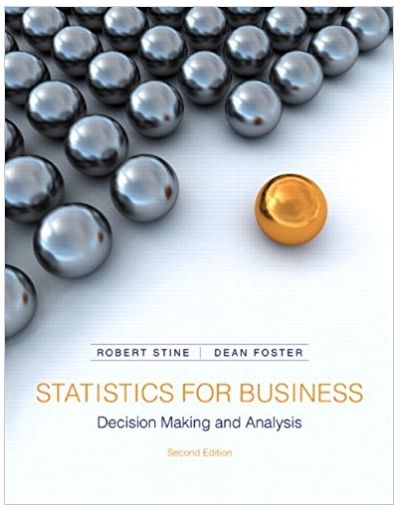The prior 4M exercise introduces the Capital Asset Pricing Model. The slope and intercept in this model
Question:
The importance of β0 and β1 in finance leads analysts to want better estimates. The prior exercise uses monthly data, but this exercise introduces daily returns. Here’s the question: Can we get better estimates of β0 and β1 from daily data? To put the estimates of β0 on common scales, let’s annualize the estimated rate of return. For monthly data, annualize the estimate of β0 by multiplying by 12. For daily data, multiply the estimate by 250. (A typical year has 250 trading days.) Estimates of β1 require no adjustment.
The two data tables in this example describe returns on stock in Apple. The data in Exercise 48 uses 264 monthly returns on Apple from 1990 through 2011. The second data table, new for this example, provides 5,547 daily returns on stock in Apple over this same period.
Motivation
(a) What is the importance of knowing β0 more accurately? People in finance care a lot about this quantity, but why?
(b) Why would you expect that using daily data rather than monthly data over a given time period would produce more accurate estimates of β0 and β1?
Method
(c) Verify that the SRM that sets Y to be returns on stock in Apple and sets X to be returns on the market meets the needed conditions. Be sure to consider both sampling rates (daily and monthly) and note any outliers or anomalies.
(d) How can you use confidence intervals based on the estimates of β0 and β1 from the two fitted regression equations? Will they be identical? How close is close enough?
Mechanics
(e) Fit the two simple regression models, one using daily data and the other monthly. Interpret the estimates of β0 and β1 in each case.
(f) Form interval estimates of the annualized mean return on the idiosyncratic risk for the daily and monthly data. Are the intervals compatible, in the sense of both center and length?
(g) Compare the estimates of beta from the daily and monthly data. Are the intervals compatible, in the sense of both center and length?
Message
(h) Give an interval estimate of the annualized mean return on the idiosyncratic risk and β1 for Apple. As part of your message, make sure that you’ve rounded appropriately.
(i) If you could get data on a finer time scale, say every 30 minutes, would you be able to get better estimates of β0 or β1? (High frequency data track the price of a stock with every trade, producing returns on a very fine time scale for actively traded investments.)
Fantastic news! We've Found the answer you've been seeking!
Step by Step Answer:
Related Book For 

Statistics For Business Decision Making And Analysis
ISBN: 9780321890269
2nd Edition
Authors: Robert Stine, Dean Foster
Question Posted:





